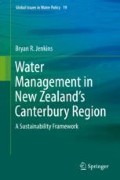Abstract
A central theme of this book is the definition of potential failure pathways that can lead to socio-ecological system collapse and then the derivation of sustainability strategies to address these potential failure pathways so that a socio-ecological system has the capacity to manage system-threatening disturbances and maintain its structure and function, i.e. that the socio-ecological system is sustainable. The collapse of the Maya is of value to this theme because of the variety of theories that scholars have put forward for the reasons for the collapse based on the interaction between socio-economic and biophysical systems at several spatial scales as well as the significance of water management in the collapse.
Categories of failure pathways are distilled from these theories of collapse and then placed in the framework of nested adaptive systems . A framework for analysing the resilience of societal systems to major disturbances is then developed. Approaches to the development of sustainability strategies are described within the same framework based on the principles of ecosystem stewardship.
Access this chapter
Tax calculation will be finalised at checkout
Purchases are for personal use only
Notes
- 1.
For example, “a lower degree of stratification and social differentiation” Tainter (1988), p. 4.
- 2.
Tainter considers a number of resource depletion explanations including deterioration due to human mismanagement, loss due to environmental fluctuation or climate shift, and, loss of trade networks for external resources and imported goods. Tainter (1988), pp. 44–51.
- 3.
Gunderson and Holling refer to “conservation” rather than “accumulation ”. Accumulation is considered to have wider application for dealing with both storage in systems for productive purposes and build-up of contaminants which can have adverse effects.
- 4.
The pathway numbers chosen to match the numbering of the four types of issues in Figure 4.6.
- 5.
As stated by Tainter: “After a certain point increased investments in complexity fail to yield proportionately increasing returns. Marginal returns decline and marginal costs rise. Complexity as a strategy becomes increasingly costly and yields decreasing marginal benefits” (Tainter 1988).
- 6.
Tainter’s other complex societies leading to competition between societies is a ‘cold war’ version of this pathway.
- 7.
This is consistent with Tainter’s two reasons for establishing complex societies: management of conflict, and, facilitation of integration.
- 8.
This is the outcome of the collapse of the Classic Maya.
- 9.
The release of seed source at the bioregion scale to facilitate revegetation at the watershed and land parcel scale as depicted in Fig. 4.4 is an example of a stabilising feedback loop.
References
Binford, M. W., Brenner, M., Whitmore, T. J., Higuera-Gundy, A., & Deevey, E. S. (1987). Ecosystems, paleoecology and human disturbance in Subtropical and Tropical America. Quaternary Science Review, 6, 115–128.
Chapin, F., Kofinas, G., & Folke, C. (2009). Principles of ecosystem stewardship: Resilience-based natural resource management in a changing world. New York: Springer.
Coe, M. D. (2005). The Maya (7th ed.). London: Thames and Hudson.
Diamond, J. (2005). Collapse: How societies choose to fail or survive. London: Penguin.
Dunning, N. P., & Beach, T. (1994). Soil erosion, slope management and ancient terracing in the Maya lowlands. Latin America Antiquity, 5(1), 51–69.
Freter, A. C. (1992). Chronological research at Copan: Methods and implications. Ancient Mesoamerica, 3, 117–133.
Freter, A. C. (2004). Multiscalar model of rural households and communities in late Classic Copan Maya society. Ancient Mesoamerica, 15, 93–106.
Gunderson, L. H., & Holling, C. S. (2002). Panarchy: Understanding transformations in human and natural systems. Washington, DC: Island Press.
Holling, C. S. (1978). Adaptive environmental assessment and management. Chicester: Wiley.
Jenkins, B. R. (2016). Sustainability analysis of the management approach for six New Zealand lakes. Lake and Reservoir Management, 32(2), 101–115. https://doi.org/10.1080/10402381.2015.1135491.
Lucerno, L. I. (2002). The collapse of the Classic Maya: What happened to Classic Maya civilisation? American Anthropologist, 104(3), 814–826.
Millennium Ecosystem Assessment. (2005). Ecosystems and human well being: Synthesis. Washington, DC: Island Press.
Paton, D., & Johnston, D. (2006). Disaster resilience: An integrated approach. Springfield: Charles C Thomas.
Rice, D. S. (1978). Population growth and subsistence alternatives in a tropical lucastrine environment. In P. D. Harrison & B. L. Turner (Eds.), Pre-Hispanic Maya Agriculture (pp. 301–344). Albuquerque: University of New Mexico Press.
Scarborough, V. L., & Gallopin, G. G. (1991). A water storage adaptation in the Maya lowlands. Science, 251, 658–662.
Sharer, R. J. (1977). The Maya collapse revisited: Internal and external perspectives. In N. Hammond (Ed.), Social process in Maya prehistory. London/New York: Academic.
Tainter, J. A. (1988). The collapse of complex societies. Cambridge: Cambridge University Press.
Turner, B., Kasperson, R., Matson, P., McCarthy, J., Corell, R., Christensen, L., Eckley, N., Kasperson, J., Luers, A., Martello, M., Polsky, C., Pulsipher, A., & Schiller, A. (2003). A framework for vulnerability analysis in Sustainability Science. Proceedings of National Academy of Sciences, 100(14), 8074–8079.
Walker, B., & Salt, D. (2006). Resilience thinking: Sustainaing ecosystems and people in a changing world. Washington, DC: Island Press.
Webster, D. L. (2002). The fall of the ancient Maya: Solving the mystery of the Maya collapse. London: Thames & Hudson.
Willey, G. R., & Shimkin, D. B. (1973). The Maya collapse: A summary view. In T. P. Culbert (Ed.), The Classic Maya collapse (pp. 457–502). Albuquerque: University of New Mexico Press.
Wingard, J. (1996). Interactions between demographic processes and soil resources in the Copan Valley, Honduras. In S. Fedick (Ed.), The managed Mosaic. Salt Lake City: University of Utah Press.
Author information
Authors and Affiliations
Rights and permissions
Copyright information
© 2018 Springer Science+Business Media B.V.
About this chapter
Cite this chapter
Jenkins, B.R. (2018). The Collapse of the Maya and the Development of a Sustainability Framework. In: Water Management in New Zealand's Canterbury Region. Global Issues in Water Policy, vol 19. Springer, Dordrecht. https://doi.org/10.1007/978-94-024-1213-0_4
Download citation
DOI: https://doi.org/10.1007/978-94-024-1213-0_4
Published:
Publisher Name: Springer, Dordrecht
Print ISBN: 978-94-024-1212-3
Online ISBN: 978-94-024-1213-0
eBook Packages: Earth and Environmental ScienceEarth and Environmental Science (R0)

